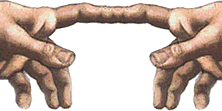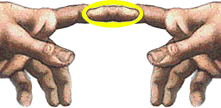@1x.png)
If you have two roughly equivalent eyes you will see a ‘sausage’ floating in front of you in mid air, by following these steps:
Correctly this should be named “Floating Finger Illusion” (Sharp 1928). Basically, the ‘sausage’ is caused by two mechanisms, (1) physiological double images and (2) interocular rivalry and suppression.

When you look at your fingers, the gaze direction of your two eyes is angled towards each other, so that their lines of sight meet at the target. When you then look into the distance, your eyes shift slightly outward, making their lines of sight nearly parallel. For close objects the image in the two eyes is consequently no longer at the right position, the images are no longer merged and can appear double for your “inner eye”. This is quite normal and occurs all the time, usually these double images are suppressed. So, if the two images overlap, why then doesn’t the compound image look like the neighbouring figure on the right? 
At the end of the image of each finger, there is a rivalry between the image from the two eyes when the brain tries to combine them. In one eye the finger ends, in the other it continues. So what does your brain do in such rivalry situations? If the two images are rather similar, the percept can oscillate between the alternatives. Here, however, we have a high contrast step in one eye, namely the end of the finger, where it is replaced by the background. In rivalry the eye with the higher contrast wins, at least locally; this is here meant by the term ‘suppression’. In the figure on the left this high contrast step is symbolised by the yellow halo.
Sharp WL (1928) The floating-finger illusion. Psychological Review 35(2):171–173 (thanks to Manfred Fahle who dug up this original source)
Alais & Blake 2004: a book on binocular rivalry
Randolph Blake’s pages on rivalry (with demos)